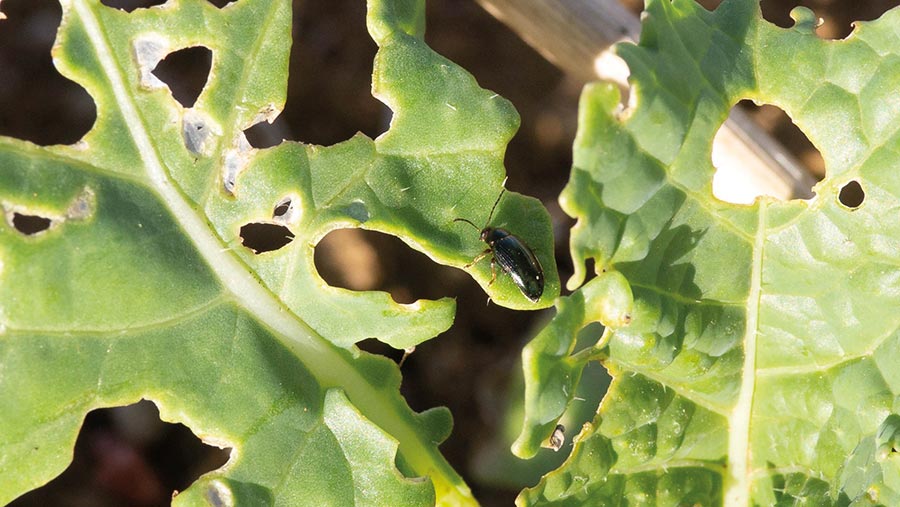Study shows growers can cut oilseed rape pest damage
 © Tim Scrivener
© Tim Scrivener Agro-ecological and genetic solutions are being examined to overcome pest problems in oilseed rape.
Rothamsted Research is doing work on increasing populations of natural enemies as part of a Europe-wide EcoStack project.
The results show that growers can use practices to either reduce pest numbers or their effect on the crop, such as companion cropping, using bespoke field margins and encouraging pest predators, which can involve no-tillage.
Companion cropping
A reduction in cabbage stem flea beetle damage was seen when cereals or unattractive brassica companions were used, reports Gaetan Seimandi-Corda, who adds that the effect of clover as a companion is dependent on its density.
“The denser the clover population, the less damage was observed.
“Straw mulch was also effective in reducing attacks,” says Dr Seimandi-Corda.
Bespoke flower margins
Where flower margins were established, Rothamsted’s results indicated that certain wildflower species are more attractive than others – with different insect species favouring different plants.
There are also differences between plants favoured by pollinators and those preferred by parasitoids, so bespoke mixes may be needed.
“The next stage is to identify the flower traits that explain these preferences so we can come up with the best seed mixes for attracting beneficials,” he says.
Predators of OSR pests
Both carabids and rove beetles are key predators of oilseed rape pests, especially pod midge and pollen beetle larvae.
“Beetles eat the soft-bodied forms of pests on the soil surface. So they have a suppression effect, reducing numbers before they can become a problem in the crop,” says Rothamsted’s Kelly Jowett.
Building carabid numbers is important, which is why a range of connected farm habitats is key.
“They need the resources to feed, breed and shelter, so a range of crops with some adjacent semi-natural habitat is ideal,” says Dr Jowett.
Rape winter stem weevil
Winter stem weevil has been an issue in East Anglian crops this season, with some going backwards after Christmas and dying off from the effects of larval feeding and sharp frosts.
The larvae have a distinctive C-shape with dark orange heads, and often live alongside flea beetle larvae, invading the main stem and developing crown.
Earlier drilling may have suited the pest, says Dick Neale, technical manager at agronomy group Hutchinsons, as the adults have an earlier egg laying period than flea beetles.
“We may have unintentionally played into their hands by drilling earlier to avoid another pest.
“Unfortunately, the only solution is to spray, which most growers are trying not to do,” he says.
Earlier drilling wasn’t to blame in the crops of AHDB Diss Monitor Farmer Richard Ling, who lost 20ha of hybrid oilseed rape to the pest, after it had established well from a September drilling.
“It started to go backwards in mid-January. Fortunately, I hadn’t spent the money on an Astrokerb application and the seed was left over from the previous year, so I was able to make the decision to rip it up without being out of pocket,” he says.
A replacement spring barley crop is up and growing well.
Mr Ling won’t be making the same mistake twice.
“Oilseed rape is still in my future plans, providing conditions are good at drilling and there’s enough moisture, and that we don’t run over into September.”
Genetic solutions?
Twenty oilseed rape varieties are being put through their paces at Rothamsted for flea beetle larval tolerance.
At least two of the varieties in this year’s trial have a trait, identified by the John Innes Centre, that helps the plant tolerate larvae infestations, says Sam Cook of Rothamsted.
Next year, the study will expand to include varieties with a trait for adult flea beetle tolerance.
“There is every reason for growers to be optimistic about the future place for oilseed rape in rotations, despite some of the current challenges,” says Dr Cook.
Tillage effect on beneficials
Parasitoid emergence is highest in no-tillage situations with the effect increasing over time since cultivations ceased, according to EcoStack.
What is OSR Future?
Corteva Agriscience is delighted to sponsor OSR Future, a series following the progress of the 2022-23 oilseed rape crop and exploring how farmers are changing the way they grow the crop.
OSR is a vital part of the rotation and Corteva remains committed to helping deliver the tools to ensure the crop has a bright future with farmers.
With an innovative R&D pipeline, fantastic varieties – such as sclerotinia-tolerant hybrid PT303 – alongside proven crop protection products, such as Belkar, Astrokerb, Kerb Flo 500 and Korvetto, farmers will be equipped with the tools they need to maximise the potential of their crops.
About the survey
The Farmers Weekly oilseed rape survey was carried out in September/October 2022 and had 353 respondents, representing all areas of the UK.
The average farm size was 406ha and the average area of oilseed rape grown was 95ha. Of those questioned, two-thirds have grown oilseed rape every year for the last five years.


